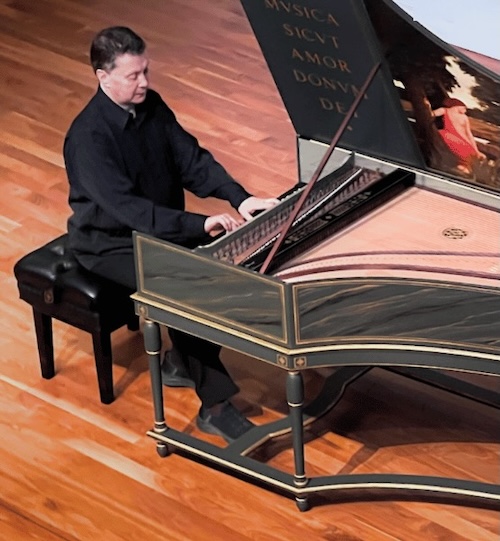Performances
Young artists provide rewards as Wolf Trap Opera opens season with Mozart’s “Figaro”
Wolf Trap Opera opened its 2025 season with a production of […]
Heyward wraps Baltimore Symphony season with “Aida” to launch Verdi project
Jonathon Heyward ended his second season as music director of the […]
Classic film music outshines concerto premiere with NSO
The National Symphony Orchestra offered a survey of music from American […]
Koh closes first Fortas season with a solo Bach marathon
Jennifer Koh has reinvigorated the Fortas Chamber Music Concerts series at […]
Chesapeake Music brings a varied array to venerable chamber series
Chesapeake Music has been presenting its summer music festival for forty […]
Articles
Trump’s takeover of the Kennedy Center was wrong—but don’t make things worse by boycotting the musicians
President Donald Trump’s controversial takeover of the Kennedy Center has roiled […]
Opera Lafayette to premiere oldest known opera by black American composer
Sometimes finding a musical treasure is sheer serendipity. A librarian cleaning […]
Concert review
Vinikour serves up an engaging Scarlatti survey for Capriccio Baroque

Jory Vinikour performed harpsichord sonatas of Domenico Scarlatti Saturday night for Capriccio Baroque. Photo: CB
Domenico Scarlatti wrote over 500 single-movement sonatas for harpsichord, all published when he was working as a court musician in Portugal and Spain.
Scarlatti’s sonatas take a free approach to form, capturing the caprices of improvisation. Many are steeped in Iberian culture, evoking characteristic instruments, modes, or moods. They are less traditionally polyphonic and more vernacular than the keyboard works of J.S. Bach and Georg Friederich Handel, who, like Scarlatti, were born in 1685. As a group, the sonatas’ technical brilliance and invention create a summit for the intrepid harpsichordist to climb.
On Saturday night, Jory Vinikour, a harpsichordist of great repute, came to Live! At 10th and G to take his shot at it, performing a full concert of Scarlatti sonatas under the auspices of Capriccio Baroque. Frustratingly, the program provided just the key and the Kirkpatrick catalog number of each sonata, with no information about the composer or music, or even tempo markings. Nor did Vinikour provide any remarks from the stage.
Vinikour’s playing, however, was a model of directness and clarity. He judged his tempos well, made sure melodies emerged from even the busiest accompaniment, and navigated the many technical challenges of these works with surety of purpose, serving the music.
Vinikour grouped the 17 sonatas on the program into four sections, with some simpler, earlier sonatas in the first group; these sang with well-chosen rhythms and transparent textures. By the last piece in this group, the Sonata in D Minor, K. 32, we began to hear the full force of Scarlatti’s invention. Cast, like most of these works, in binary form, the sonata’s A section began with a plaintive, slow minor melody, which Vinikour sustained like a breath, but the B section switched abruptly to the major mode in a whizzing rush of notes, a thrilling contrast heightened by Vinikour’s dazzling playing.
The other groups of sonatas didn’t appear to have any themes, but they did have ample highlights. In the Sonata in D Minor, K. 120, Scarlatti calls for the left hand to constantly cross over the right and back again, jumping from the top to the bottom of the keyboard until it’s almost disorienting, rendered sharply by Vinikour. Another sonata in D minor, K. 517, tested the limits of the harpsichord with its sheer volume of notes at a Prestissimo tempo and some more perilous left-hand crosses, all of which Vinikour ably dispatched.
Vinikour rendered a more subtle but no less powerful effect in the Sonata in E-Flat Major, K. 474, where the music flickered between major and minor from phrase to phrase and section to section, an ambiguity that never quite resolved, unsettling in a good way. The Sonata in C Major, K. 460, had more violent contrasts, beginning with a cheerful melody that receives a stormy riposte, followed by an abrupt modulation to a distant minor key. Vinikour sharply etched the drama while making every moment a part of the overall structure.
Vinikour showed the more tender side of Scarlatti’s invention as well. The Sonata in A Major, K. 208, felt like a lullaby, with Vinikour gently sustaining the melody at the Adagio e cantabile tempo marking and using the two keyboards on the Colin Booth harpsichord to subtly vary the texture.
For encores, Vinikour played three more Scarlatti sonatas, making an even 20 for the evening. The first of these, the Sonata in G Major, K. 146, felt almost giddy, with virtuoso riffs interrupting the melody at every turn. The final two seemed particularly special to Vinikour, as he mentioned that he had made their acquaintance early in his life through the recordings of Vladimir Horowitz. The Sonata in B Minor, K. 87, had a mournful melody that Vinikour said he takes at a Largo tempo, keenly felt throughout. Vinikour sent the audience out the door with fireworks in the Sonata in D Major, K. 96, marked Allegrissimo and as fast and fizzy as that tempo implies.
Before the concert, Capricco Baroque executive director Carolyn Winter announced that the concert was something of a preview for Vinikour’s upcoming recording, a two-CD set of Scarlatti sonatas. If this concert is any guide, that recording should be worth a listen. Hopefully it will have some notes.
Capriccio Baroque will open its 2025-2026 season with Festival Capriccio in October and November. Dates and programs are TBA. capricciobaroque.org
Calendar
July 4
U.S. Army Band Brass Quintet
Thomas Sheehan, organist
Music […]
News
Daniel Hope to succeed Wu Han as Wolf Trap artistic adviser
Wolf Trap Foundation for the Performing Arts announced Friday morning that […]
Five premieres, Puccini’s “Il Trittico” on tap in NSO’s 2025-26 season
The Kennedy Center announced the 2025-26 season Thursday morning for both […]
